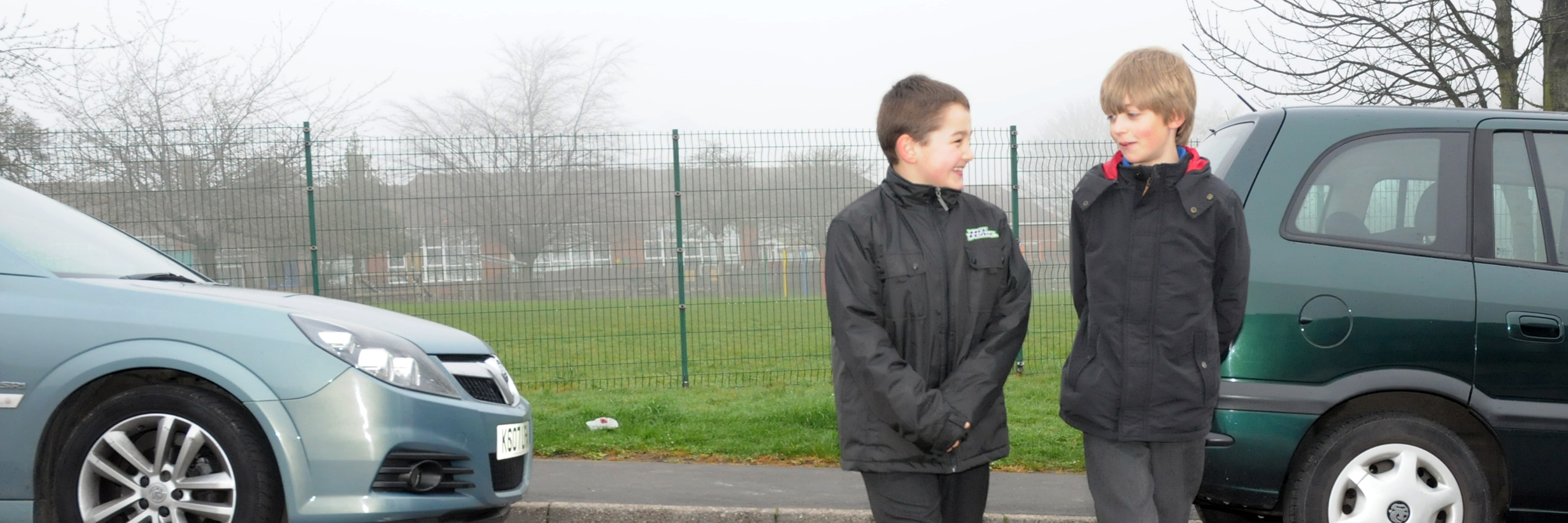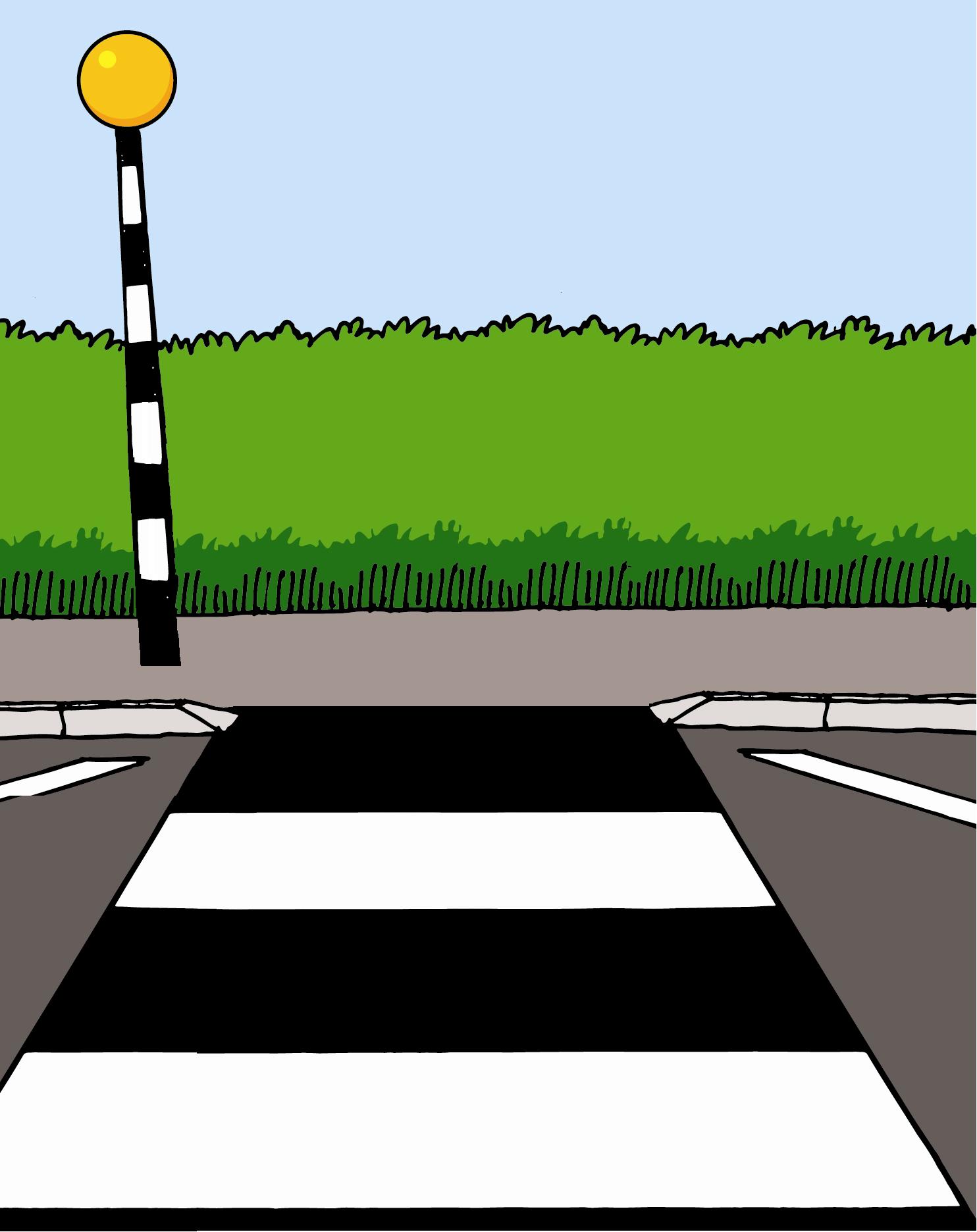At the roadside
.jpg)
Be Bright, Be Seen
When you are out and about near roads it is important that other road users can see you. This is made harder when it is dark outside or the weather is bad.
During the winter months, you are more likely to be outside in weather like fog and snow when visibility is reduced. In October the clocks change and it begins to get darker earlier on in the day, which means there is more chance of you being outside when it goes dark.
So, what can you do to be safer on the roads?
 Firstly, wearing bright colours! Fluorescent or neon colours are brilliant. Bright aren’t they?
Firstly, wearing bright colours! Fluorescent or neon colours are brilliant. Bright aren’t they?
These can help drivers to see you better if it is dull and grey outside. Fluorescent colours will show up well in daylight when you are going to and from school but are not very effective once it goes dark, therefore we need something else as well as just being bright.
Here are some examples of what you could wear to be bright: jackets, hats, bags and even stickers. There are many more out there.
Check out BrightKidz website, they have lots of Fluorescent items you can buy.
Secondly, we have to have something reflective! To be seen well when it is dark you need to wear reflective materials that to glow brightly when lights shine on them.
If you can, try to wear something that is both reflective and fluorescent which will make it easier to see you in the day and at night. You do not have to buy anything special to Be Bright and Be Seen, you can accessorise your bags and coats with stickers and key rings.
Crossing the road: The Green Cross Code
The Green Cross Code is a set of useful instructions to try and help you cross the road safely. Many children (and adults) get knocked down because they do not know how to cross the road properly or because they don't look for a safer place to cross.
The Green Cross Code can is easy to remember.
Think, Stop, Look, Listen, Think
 |
 |
 |
 |
 |
THINK!
Where are you wanting to get too? Do you have any distractions to put away?
STOP!
Do not just walk or run straight into the road. STOP before you get to the kerb. Leave a bit of room so you are not standing too close to the traffic. Little children should hold their grown-ups hand or a buggy as not to be tempted to run into the road.
LOOK!
Take a good look all around you. It is important that you can see clearly in all directions as traffic could come from anywhere. Look right, then left and then check your right again to make sure nothing has changed.
LISTEN!
It is important that you have a good listen as well if you are trying to cross safely. Sometimes you can hear the traffic coming before you can see it. A vehicle may sound louder the closer it is to you.
THINK!
Have a think about what you can see and hear. Are you crossing in the safest place or is there somewhere safer to cross, like a pedestrian crossing. If there is traffic coming, let it pass before looking and listening again, until it is safe to cross. Remember, even if traffic seems to be a long way off it may be approaching very quickly. If you are at a pedestrian crossing make sure the traffic has stopped before you step into the road. When you decide it is safe to cross, then cross in a straight line to the other side. DO NOT run. Keep looking and listening as you cross in case there is a change in the traffic around you. Watch out for cyclists and motorcyclists travelling between the lanes of traffic.
Remember
If there is no dedicated pedestrian crossing it is important that you choose somewhere where you can see clearly in both directions and where drivers can see you.
In the UK the traffic travelling nearest to you will generally be coming from the right. In some cases the traffic will travel from the left (e.g. some one way roads). In this case you should look left, then right and double check the left side before stepping into the road.
Emergency services such as the Police, Fire Service and Ambulance Service will all have their blue lights flashing and their sirens going if they are on their way to an emergency. If you see one coming, take a step back and let the vehicle pass.
Wherever you can, try and cross the road at a pedestrian crossing. There are different types of pedestrian crossings, traffic lights control some of them, and a crossing warden controls another.
Crossing the road: Pedestrian crossings and other safe places to cross
There are four different types of traffic light pedestrian crossings that use the red and green figures:
• Pelican Crossing
• Puffin Crossing
• Toucan Crossing
• Pegasus Crossing
 Pelican Crossing
Pelican Crossing
Pelican crossings are controlled by traffic lights. If you want to use a Pelican Crossing, you need to press the button on the wait box, which is usually on your right hand side. It may be on your left if it is a one-way street.
Wait for the green man to appear before checking that all the cars have stopped and it is safe for you to cross.
You will find the box with the red and green man across the street in front of you - can you see it in the picture?
If the green man begins to flash DO NOT start to cross the road but if you are already crossing then continue safely to the other side of the road.
Keep checking in both directions, listening carefully until you are safely at the other side of the road.
To find out about the other types of traffic light pedestrian crossings visit the Safer Places to Cross page of the Junior Road Safety Officers section of this website.
Other types of pedestrian crossings
The other safer places to cross that are NOT controlled by traffic lights are:
 Zebra Crossing - it is easily identifiable by the alternating coloured stripes painted on the road (which are usually black and white) and a flashing light on each side of the road called a belisha beacon. Traffic is expected to stop to allow a pedestrian to cross the road when they are stood at the side of the road waiting to cross. To use a Zebra Crossing you need to stand on the kerb wait for the traffic to stop. Don't stand too close incase the traffic is travelling too close to the kerb. Once the traffic has stopped and it is safe for you to cross the road walk on the stropes in a straight line until you reach the other side.
Zebra Crossing - it is easily identifiable by the alternating coloured stripes painted on the road (which are usually black and white) and a flashing light on each side of the road called a belisha beacon. Traffic is expected to stop to allow a pedestrian to cross the road when they are stood at the side of the road waiting to cross. To use a Zebra Crossing you need to stand on the kerb wait for the traffic to stop. Don't stand too close incase the traffic is travelling too close to the kerb. Once the traffic has stopped and it is safe for you to cross the road walk on the stropes in a straight line until you reach the other side.
Remember - although you are waiting to cross some cars will not stop like they should. Make sure it is safe before stepping into the road by using your Green Cross Code.
School Crossing Patrol Officer - These patrol officers are also known as a Lollipop Lady or Lollipop Man. This nickname was derived in the 1960s as the circular stop sign used to stop the traffic resembles a lollipop. A School Crossing Patrol is only in operation when children are on their way too or from school when there is a high number or pedestrians needing to cross the road safely. When a pedestrian needs to cross the road the patrol officer stops the traffic by showing oncoming cars the stop sign. When the cars have stopped they walk into the centre of the road until all the pedestrians are safely on the other side before returning to the kerb and allowing the traffic to move again.
Footbridge - is a bridge designed to allow pedestrians (and sometimes cyclists) away from the traffic below. Footbridges may also allow you to cross rivers and railway tracks safely.
Underpass / Subway - A tunnel that passes underneath a busy road or railway giving a pedestrian a safer way to travel to the other side, keeping them away from the traffic above. In larger areas like town centres you may find that two or more underpasses meet in the centre of a roundabout and there are multiple exits taking you in different directions.
Pedestrian/Refuge Island is a small section of pavement in the middle of the road. It is typically used when a road is wide to give pedestrians a safer place to stand allowing them to tackle the traffic in each direction separately.
Peer learning
Peer learning allows students to learn from one another. We encourage students to help us spread important road safety message to their counterparts in school, through initiatives such as the Junior Road Safety Officer scheme. For older students, aged 11-16 years, we have in the past set challenges to devise a drama piece incorporating a number of age related road safety messages. The piece is then filmed or the production is performed and shown to all students in school, thus conveying road safety messages to a wider audience.
Here are just a few of the pieces that have been produced in the past covering the important topic of safety at the roadside, in particular the risks of being distracted.
Thank you to the contributors from:
